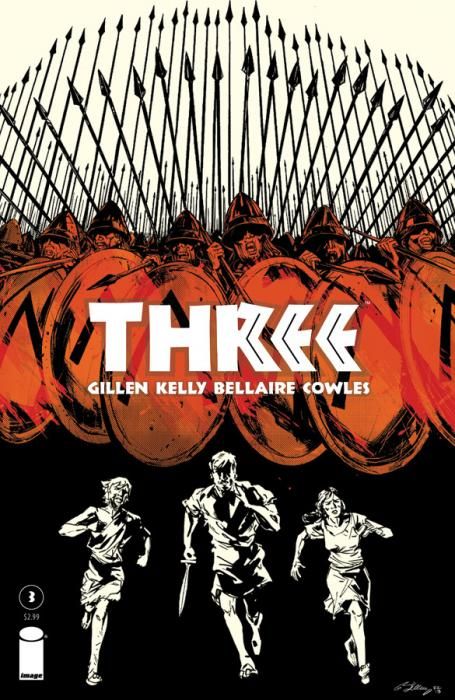After Issue #2 took on a great deal of the slower moving exposition, "Three" #3 is (fittingly, I suppose) executed pretty much perfectly. The pacing is tight, the characterization is taut, and the new elements of the story contribute to the reader's understanding of the world rather than confuse the overall arc. There's really not a misstep to be found.
Much of the credit for this falls to the pacing, which is fueled by a surprisingly un-Gillen excess of silent panels. I've never had a problem with Gillen's plotting, but his scripts usually tend wordier. Issue #3, on the other hand, really lets Kelly's art breathe, and the scenes feel at once quicker and more pregnant with meaning as a result.
Because let's face it: that Ryan Kelly has an eye for brutality. Even when the Spartans are only shaving off half of Arimnestos' beard, the panel has a more visceral sense of violence than many other titles' climactic battles. Glances, postures and small gestures are all injected with an air of menace and impending physical harm. It's remarkable - and essential, in a book that is so centered on the state's use of violence to maintain control. For "Three" to work, the reader needs to feel how oppressive and omnipresent this threat of violence is, and Kelly's inks and Bellaire's colors create a truly unnerving landscape that never looks safe.
Gillen also drives this point home with his script. No matter the situation, the only effective response open to his characters is violence. In modern democracies, we're taught that our words, and our ability to speak truth, can change things. In "Three," Terpander's mouth only ever gets him and his fellow slaves into trouble, or fails to get them out of it. Klaros' ability to butcher? Works every time.
Klaros also gets some more development in Issue #3, as does Damar. Gillen makes nice use of his historical research to build his characters, revealing that the Helots actually choose their own call-names. Terpander took the name of a forbidden poet, Damar ironically calls herself 'tamed', and Klaros really calls himself Stenyklaros, after the slaughter of the Spartans. Damar also reveals more about her personal history, in a brilliantly colored, shiver-inducing sequence that combines bloodstains with nostalgic grayscale. Bellaire never fails to add something unexpected.
Historical research is also well utilized in the development of the new characters, including the Helot tracker and Aristodemos of the Skiritai, but Arimnestos and his mother bring the most to the story. Arimnestos, the surviving Spartan who fled when the three Helots fought back, is rejected as a 'Trembler' by a society now controlled by those who 'Trembled' before the Thebans years ago. Enraged, he decides to follow the Three, adding another tracker with a different agenda to the mix. He's an interesting third piece, and I am excited to see how this plays out. However, the showstopper in this issue is actually Arimnestos' mother, Gyrtia. She is a cold, confident horror show who's well used to illustrate not only the power of wealthy Spartan women, but the devastation and utter rejection of being labeled a trembler.
With all of these elements going for it, "Three" is simply masterful. It's also full of masters...but I'll stop punning. Go get the issue already.

